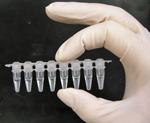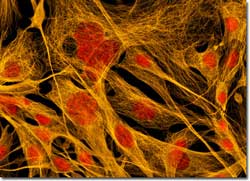Discuss this article on the forums
 There was something for everybody (or not for everybody) on the Twiv podcast – yes they felt the dangers of contamination were real, no the Retrovirology papers did not prove anything, sequence variation could be confounding results, etc….
There was something for everybody (or not for everybody) on the Twiv podcast – yes they felt the dangers of contamination were real, no the Retrovirology papers did not prove anything, sequence variation could be confounding results, etc….
Dr. Rein has worked extensively on murine leukemia viruses and HIV. Dr. Rein noted that the gene sequences found by Dr. Lo and Alter were gene sequences commonly found in mouse DNA and in endogenous retroviruses. Dr R noted that they went to a lot of trouble to ensure that these are not gene sequences from mice. Dr. Rein agreed that did not think that the mitochondrial DNA test that they did was the best test for mouse DNA and felt that IAP DNA assay would have been quite a bit more sensitive.
Nobody disagrees that XMRV and the Lo/Alter sequences are similar to endogenous mouse retroviral sequences; the disagree comes on what that means. Are you a lumper? (XMRV is not different enough) Or a splitter? (Its definitely different enough). Stoye is a lumper, Miller is a splitter and Coffin is something….:)
IAP Test – Because one study showed it was possible for a mtDNA test to miss mouse DNA that the IAP test is able to pick up they agreed that it would be best for the positive studies to go back and retest their samples using the IAP test. (This suggests, though, that the mtDNA is completely inadequate for finding mouse DNA. Sure it’s possible that it misread some samples…but how is it possible for it to misread 70 out of 100 samples? So, yes, for accuracies sake, go back and retest the samples….but to fine tune the results – not overturn them…
Variable enough? -a big question making the rounds is if XMRV (or the Lo/Alter sequences) are genetically variable enough. A replicating virus should be quite variable from person to person while a contaminant would not. XMRV does not, as yet appear to be very variable genetically. Dr. Rein noted, however, that XMRV is very different from HIV and, given that, there is really no way to tell how variable a replicating XMRV should be which means you can throw the low genetic variation assertions out the window – the virus is too new to know what low genetic variation means.
 The Prostate, Immunohistochemistry and Dr. Singh’s Study – Dr. Rein also looked for XMRV in hundreds of prostate cells and found none. Rather disturbingly he described a process, too complicated for me to get on the first pass, in which it was possibly for immunohistochemistry samples to register as false positives. Immunohistochemistry has been Dr. Singh’s bailwick; she has claimed that immunohistochemistry is more accurate than PCR in finding XMRV but Dr. Rein reported that his analysis of some of Dr. Singh’s positive slides suggested that they were actually negative. Dr. Singh, appears to be using immunohistochemistry in her XMRV autopsy study. Dr. Singh, of course, was not on the program and did not have a chance to defend her study. Dr. R did note that a recent paper came out that did found XMRV in prostate cancer tisssues…..the twists and turns this field is still taking continue to be amazing.
The Prostate, Immunohistochemistry and Dr. Singh’s Study – Dr. Rein also looked for XMRV in hundreds of prostate cells and found none. Rather disturbingly he described a process, too complicated for me to get on the first pass, in which it was possibly for immunohistochemistry samples to register as false positives. Immunohistochemistry has been Dr. Singh’s bailwick; she has claimed that immunohistochemistry is more accurate than PCR in finding XMRV but Dr. Rein reported that his analysis of some of Dr. Singh’s positive slides suggested that they were actually negative. Dr. Singh, appears to be using immunohistochemistry in her XMRV autopsy study. Dr. Singh, of course, was not on the program and did not have a chance to defend her study. Dr. R did note that a recent paper came out that did found XMRV in prostate cancer tisssues…..the twists and turns this field is still taking continue to be amazing.
New Viruses – New Sequences – New Problems – Dr. Rein emphasized an important point on sequence variation. He noted that if the sequence you’re looking for is a little different from the published sequence then you can miss it. He said that was an inherent ‘risk’ in PCR and can lead to false negatives. Sequence variation, then, is a real question given the newness of XMRV and how little researchers understand it. Basically he’s saying you cannot draw any inferences from that fact that sequence variation at this point looks low!
Antibodies are constructed to match up XMRV and other similar viruses should be able to pick it up variations of the virus and ditto with the immunohistochemistry results
Contamination – They went into a scary scenario – which does not seem to playing out at all – of the water controls researchers use possibly being contaminated from mouse DNA from mouse droppings coming from reservoirs. (No water controls have tested positive because of this reason, yet….this is not an issue with the XMRV studies). They went on for a while about contamination scenario’s…a millionth of a microliter of mouse DNA (much less than a cell) would be detectable da da a….
The 22Rv1 Cell Line is Not a Smoking Gun – this was perhaps the most important thing we learned from this talk. 22Rv1 is a human prostate carcinoma cell line derived from human tissue which was then grown in mice several decades ago. It’s ability to produce prostate cancer cells it a useful cell line for prostate cancer researchers. In 2009 Knough et. al. found a pathogen in their 22Rv1 cancer cell line that turned out to be XMRV. It’s now clear that along with prostate cancer cells the 22RV1 cell line also produces high quantities of XMRV. (This cell line is actually sold online (with instructions on how to grow it) for $273! )
 The Knough paper suggested that the 22Rv1 cells were infected with XMRV during ‘passage’ through mice and noted that care should be taken not to contaminate lab personnel (!) with this virus and/or other lab experiments, etc. The Hue paper’s findings suggested that the XMRV in prostate cancer tissues and in CFS blood samples may have been derived from this 22RV1 cell line. At this point this is a supposition only and there is no evidence that such is the case.
The Knough paper suggested that the 22Rv1 cells were infected with XMRV during ‘passage’ through mice and noted that care should be taken not to contaminate lab personnel (!) with this virus and/or other lab experiments, etc. The Hue paper’s findings suggested that the XMRV in prostate cancer tissues and in CFS blood samples may have been derived from this 22RV1 cell line. At this point this is a supposition only and there is no evidence that such is the case.
Hue’s findings seemed very convincing at first but doubts have definitely crept in….Dr. Rein did not agree it was possible to conclude that XMRV was derived from that cell line, and after being initially rocked by the finding, Dr. Racaniello came to the same conclusion. In fact 3 of the 4 commentators – after cheerily espousing on all the dangers of contamination – all agreed that this central finding had been overstated and one of them actually put up a blog post about that. The papers do put a stronger focus on the possibilities of contamination – and the 22RV1 theory could be correct but it has not been proven or been shown to apply to the WPI’s or other studies. They all agreed that what the field needs is what it is doing; creating strict protocols and sharing samples between labs.
A Definitive Test – XMRV Integration into human DNA. What clinched XMRV for prostate cancer was showing that it was integrated into human DNA. Dr. Rein wanted that finding replicated by other labs and it to be extended to CFS. He noted that Illa Singh is trying very hard to do that; the problem is that it takes a lot of DNA and prostate tumor biopsies do not provide much of that.
In his next blog Dr. Racaniello took up the question of XMRV integration into the genome…
 How to confirm this has happened? ‘Simply’ amplify the viral DNA sequences and determine if they are bordered by human DNA. (‘Simply’ may considerably understate the complexity of this task since it has not occurred with ME/CFS yet and only partially prostate cancer). If viral DNA is bordered by human DNA you have evidence that the virus has entered a human cell and burrowed into human DNA. At that point it doesn’t matter where the virus came from; it’s now infected a human cell and is now an infectious human virus. Which bring up another issue…
How to confirm this has happened? ‘Simply’ amplify the viral DNA sequences and determine if they are bordered by human DNA. (‘Simply’ may considerably understate the complexity of this task since it has not occurred with ME/CFS yet and only partially prostate cancer). If viral DNA is bordered by human DNA you have evidence that the virus has entered a human cell and burrowed into human DNA. At that point it doesn’t matter where the virus came from; it’s now infected a human cell and is now an infectious human virus. Which bring up another issue…
It doesn’t matter where XMRV came from – if it is found to infect human cells. In the 1990’s Hooper proposed that HIV was introduced into humans by contaminated polio vaccines. A similar scenario involving vaccines was recently proposed for XMRV. or XMRV could have escaped from the 22RV1 cell line or from a lab mouse into a lab worker and then into the population. The point is once its ‘in’ the human population it’s ‘in’ and the next step is determining how many people it in.
Why is XMRV only halfway there? Because the Silverman team proved that one side of the virus was bordered by human DNA but not the other. Although they were able to show human DNA was present in every sample, and if one side is integrated in human DNA, it would seem strange that the other side wouldn’t be, Dr. Raccaniello wants more.
The isolation of the entire proviral DNA, including both flanking integration sites, from patients with prostate cancer or chronic fatigue syndrome would be additional evidence that XMRV is a virus that infects humans.
Finding XMRV was integrated into human DNA would still apparently not clinch it for Dr. Racaniello – note that he’ll only go so far as to say ‘it would be additional evidence’…One wonders what would clinch XMRV being a human infectious virus for him (and I will ask in his blog).
Down the Rabbithole – Dr. Alan Dove, in a comment posted to the blog, wants to dot even more i’s and cross some more t’s. He stated that
Besides looking at the other end to check for duplication, I’d also want to see some blinded samples from healthy controls. That’s especially important in this case, as they’re doing a preliminary linear amplification on the patient samples before doing the junction PCR. With that much amplification, and with the first step open-ended, I think there’s some room for PCR artifacts.
What about those Antibodies?They finally got to the big question the patients have been asking – what about those antibodies? Does THAT prove a real infection has occurred? Dr. Rein seemed to think yes…provided that another lab replicates those findings. (Dr. Mikovits has reported that Dr. Bagni’s antibody test confirms the WPI’s findings but that has not been published yet.) Of course many labs are developing their own antibody tests.
Doesn’t the ability to transfer virus from blood to cells in culture mean virus is there? Dr. Rein stated that if XMRV is floating around in the lab then it could get into the blood that way.

How could ME/CFS samples consistently show higher rates of XMRV infection than the controls? Dr. Rein suggested if the ME/CFS samples were handled more….but otherwise he didn’t have an answer to that and didn’t think ‘we’ have an answer to that.
What is next? Using validated assays…exchanging samples…..using different labs. Dr. Rein does not believe that large-scale case-control human studies are called for – which makes sense; what assay, after all are you going to use to test all those people? Instead he called for developing a consensus assay and then moving on – which is essentially what is occurring. . He was clear that he believes it’s possible that XMRV was a ‘mistake’ and that it’s ‘of course’ possible that XMRV is a virus infecting people.
